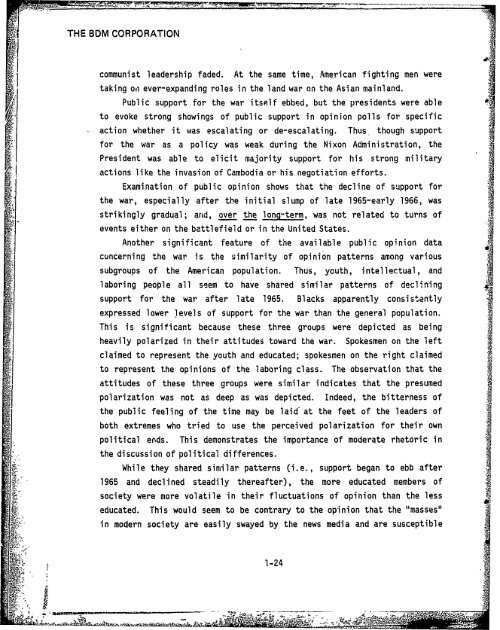policy - The Black Vault
policy - The Black Vault
policy - The Black Vault
You also want an ePaper? Increase the reach of your titles
YUMPU automatically turns print PDFs into web optimized ePapers that Google loves.
THE BDM CORPORATION<br />
•.o_<br />
communist leadership faded. At the same time, American fighting men were<br />
taking on ever-expanding roles in the land war on the Asian mainland.<br />
Public support for the war itself ebbed, but the presidents were able<br />
to evoke strong showings of public support in opinion polls for specific<br />
action whether it was escalating or de-escalating. Thus though support<br />
for the war as a <strong>policy</strong> was weak during the Nixon Administration, the<br />
President was<br />
able to elicit majority support for his strong military<br />
actions like the invasion of Cambodia or his negotiation efforts.<br />
Examination of public opinion shows that the decline of support for<br />
the war, especially after the initial slump of late 1965-early 1966, was<br />
strikingly gradual; arid, over the long-term, was not related to turns of<br />
events either on the battlefield or in the United States.<br />
Another significant feature of the available public opinion data<br />
cuncerning the war is the similarity of opinion patterns among various<br />
subgroups of the American population. Thus, youth, intellectual, and<br />
laboring people all seem to have shared similar patterns of declining<br />
support for the war after late 1965. <strong>Black</strong>s apparently consistently<br />
expressed lower levels of support for the war than the general population.<br />
This is<br />
significant because these three groups were depicted as being<br />
heavily polarized in their attitudes toward the war. Spokesmen on the left<br />
claimed to represent the youth and educated; spokesmen on the right claimed<br />
to represent the opinions of the laboring class. <strong>The</strong> observation that the<br />
attitudes of these three groups were similar indicates that the presumed<br />
polarization was not as deep as was depicted.<br />
Indeed, the bitterness of<br />
the public feeling of the time may be laid- at the feet of the leaders of<br />
both extremes who tried to use the perceived polarization for their own<br />
political erds.<br />
This demonstrates the importance of moderate rhetoric in<br />
the discussion of political differences.<br />
While they shared similar patterns (i.e., support began to ebb after<br />
1965 and declined steadily thereafter), the more educated members of<br />
society were more volatile in their fluctuations of opinion than the less<br />
educated.<br />
This would seem to be contrary to the opinion that the "masses"<br />
in modern society are easily swayed by the news media and are susceptible<br />
k' 1-24<br />
t
















